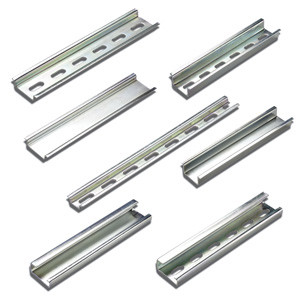Din Rail

RSP Supply carries a full line of DIN rail systems engineered for secure and efficient mounting of industrial components such as terminal blocks, relays, circuit breakers, and power supplies. These rails provide a standardized, reliable solution for organizing control panels and electrical enclosures.
DIN rails are typically made from durable materials like galvanized steel or aluminum to ensure long-lasting strength and corrosion resistance. The two most common types - top-hat rails (35mm) and G-type rails - offer stable, versatile mounting for a wide range of electrical devices. Both designs help maintain a clean, organized panel layout while protecting critical components from vibration and movement. Installation is simple: the rail mounts directly onto a back panel or enclosure surface, and compatible components snap into place using integrated clips. This quick-mount system makes maintenance and upgrades fast and efficient, allowing engineers and technicians to add, remove, or replace devices without specialized tools. DIN rail systems are essential for modern industrial automation, providing both mechanical support and electrical organization in compact spaces.
FAQs
Q: What materials are DIN rails made from?
Most DIN rails are made from galvanized steel, aluminum, or stainless steel for durability, corrosion resistance, and secure mounting.
Q: What are the most common types of DIN rails?
The most common types are the 35mm top-hat rail and the G-type rail, both of which are widely used in control cabinets and industrial enclosures.
Q: How are components mounted to a DIN rail?
Components such as relays, breakers, and terminal blocks simply snap into place using integrated mounting clips, allowing quick installation and removal.
Q: Where are DIN rail systems typically used?
DIN rails are used in control panels, automation systems, power distribution boards, and industrial enclosures to organize and secure electrical components.
Q: Are DIN rail systems standardized?
Yes. Most DIN rails follow international IEC standards, ensuring compatibility across a wide range of industrial and commercial devices.
Why Buy Din Rail from RSP Supply
RSP Supply provides high-quality DIN rail systems and accessories from trusted brands at competitive prices. With fast shipping and expert support, we make it easy to design efficient, organized control panels that meet industrial standards. Whether you’re outfitting a new system or upgrading an existing one, RSP Supply offers the reliability and service you need to get the job done right.

